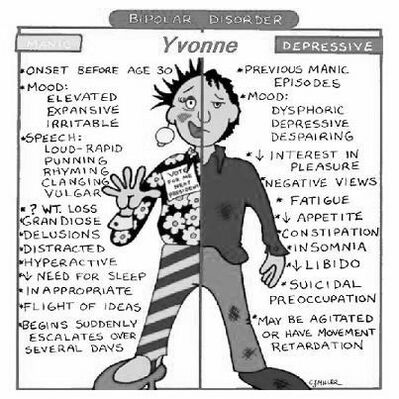Bipolar Disorder: Difference between revisions
No edit summary |
No edit summary |
||
| Line 66: | Line 66: | ||
* New frameworks for examining bipolar disorder that focus on patient empowerment and collaboration among health professionals, researchers, families and consumers are also having positive effects<ref name=":0" /> | * New frameworks for examining bipolar disorder that focus on patient empowerment and collaboration among health professionals, researchers, families and consumers are also having positive effects<ref name=":0" /> | ||
== | == Diagnosis == | ||
There are no diagnostic tests, imaging studies or lab values that are able to accurately diagnose bipolar disorder. The | There are no diagnostic tests, imaging studies or lab values that are able to accurately diagnose bipolar disorder. The correct diagnosis of bipolar affective disorder is facilitated, to a large degree, by a general clinical psychiatric assessment with the patient and their relatives, to recognize the longitudinal course of the disorder.<ref name=":1" /> | ||
== Physical Therapy Management == | == Physical Therapy Management == | ||
Revision as of 09:38, 4 September 2021
Original Editors - Michael Thompson as part of the from Bellarmine University's Pathophysiology of Complex Patient Problems project.
Top Contributors - Michael Thompson, Admin, Elaine Lonnemann, Laura Ritchie, Lucinda hampton, Kim Jackson, WikiSysop, Simisola Ajeyalemi, Wendy Walker, Amanda Ager and Tolulope Adeniji
Introduction[edit | edit source]
Bipolar disorder, once known as manic depression, is a mood disorder experienced by between 1% and 6% of the population. It’s generally a lifelong condition, characterised by swings in mood: from highs that can tip into mania, to lows that can plunge into depression.
Historically, these moods have been the concern of psychiatrists and have therefore been framed in medical terms. Everyone experiences variations in mood, but for people with bipolar disorder these variations are extreme, and require psychiatric and psychological assistance.[1]
This one minute video is about Bipolar Disorder
Etiology[edit | edit source]
Like most psychiatric disorders, the causes of bipolar disorder are complex and multifactorial. Not surprisingly, there is strong familial transmission of the disorder, as the child is exposed to both genetic and environmental risk factors.
There is also a strong developmental trajectory in bipolar disorder, with early episodes of depression typically occurring in adolescence, followed by a defining manic episode in early adulthood.[1]
Epidemiolgy[edit | edit source]
The Depression and Bipolar Support Alliance has estimated that close to 6 million Americans are affected by bipolar disorder every year. Bipolar disorder can affect anyone at any age and is found in all races, ethnic groups and social classes with the typical onset being 25 years old. Patients may be diagnosed in their early childhood to as late as the 4th and 5th decades of life. Bipolar disorder is not gender-based and can affect men and women equally. Although, studies have shown that women with Bipolar disorder have more depressive and mixed episodes than men with the disorder. More than 66% of people diagnosed with Bipolar disorder have at least one primary family member with the illness[2].
The incidence of Bipolar disorder in other countries is notable as well. In Australia it is approximately 238,957 people, in the United Kingdom it is approximately 723,248 people, in Germany it is approximately 989,095 people, in Canada it is approximately 390,094 people, in Iran it is approximately 810,038 people and for both India and China it is approximately 12-15 million people[3].
Characteristics/Clinical Presentation[edit | edit source]
Note - patients can present in a mixed state which includes features from both 'poles' of BD.
- General Appearance: A patient with mania is often hyperkinetic, unpredictable, and erratic. They often are garishly dressed, display negligence of social propriety--demonstrable via excessive friendliness, boundary violations, agitation, or other improprieties--and appear to be unnaturally "happy" or euphoric, however, irritability is also observed, dispositionally.
- Mood and Affect: Mood is often elevated or euphoric, in mania. Affect is often heightened, intense, and extremely lability. Implicit with the affective lability of mania are hyperactivity and severe mobility. When presenting in a depressive state, the patient will report a sad or elegiac mood, while expressing a congruent affect (often tearful).
- Speech: A manic patient will demonstrate pressured speech, which implies a rapid and continuous production of speech that is difficult to interrupt. Reciprocally, speech is slow and soft, in depression.
- Perception: Mood delusions may be present in either the depressed or manic phase (e.g. delusions of guilt during depressed phases or grandiose delusions of power and wealth during manic phases) A manic patient can also have mood-incongruent delusions.
- Thought Process and Content: Patients with mania demonstrate easy distractibility, lack of concentration, illogical condensations, delusions of grandiosity, and flight of ideas. A depressed patient usually has negative thoughts and negative ruminations.
- Sensorium and Cognition: Usually oriented to person, place, and time. Depressed patients may have some impairment in cognition and memory. Manic patients may have a grossly intact memory. Sometimes orientation is impaired and is called manic delirium.
- Impulse Control: Extremely depressed patients demonstrate lack of willpower. Manic patients are threatening and assaultive.
- Judgment and Insight: Impaired judgment is the distinctive feature of mania along with limited insight. Depressed patients often overemphasize their symptoms.
- Reliability: Manic patients are usually unreliable in the information they provide. Depressed patients overemphasize.[4]
Associated Co-morbidities[edit | edit source]
These co-morbidities range from mental health disease all the way to physical system disorders. "Comorbidity in Bipolar disorder; the complexity of diagnosis and treatment" reports that there are three main mental health co-morbidities associated with Bipolar disorder; anxiety, attention-deficit/hyperactivity disorder and substance abuse[5].
Health Co-Morbidities[edit | edit source]
- Anxiety
- Attention-Deficit/Hyperactivity Disorder
- Substance Abuse
- Associated medical co-morbidities include but not limited to cardiovascular disease, type two DM, and endocrine disorders[5].
Medical comorbidities are quite prevalent in patients with bipolar disorder because of the adverse effects of treatment with mood stabilizers, anticonvulsants, antipsychotics, genetic vulnerability, and lifestyle factors (poor diet, lack of exercise, alcohol use, smoking).[4]
Quick Facts:
1.35% of people with bipolar disorder are obese. This is the highest percentage for any psychiatric illness[3].
2. People with bipolar disorder are 3 times more likely to develop diabetes than are members of the general population[3].
3. People with bipolar disorder are 1.5 - 2 times more likely to die from conditions such as heart disease, diabetes and stroke[3].
Treatment[edit | edit source]
Medication assists to stabilise moods, and is the first-line treatment for acute episodes and to prevent relapses. But it’s now known that best practice treatment for bipolar disorder involves a combination of medication and psychotherapy.
Effective psychological treatments assist by providing information about the condition and risk factors and helping people identify and monitor triggers, manage stress, stabilise daily rhythms, adhere to medication, critique unhelpful thoughts and beliefs, and address substance use.
- Unfortunately, anecdotal data suggests many people never see a psychologist and, therefore, don’t receive the ongoing care that would help them to live well with bipolar disorder.[1]
- With the right assistance, the condition can be managed - a major longitudinal study found that approximately 50% of patients did not suffer significant ongoing difficulties with their symptoms. Contemporary researchers are confident that this proportion will grow as treatments advance.
- New frameworks for examining bipolar disorder that focus on patient empowerment and collaboration among health professionals, researchers, families and consumers are also having positive effects[1]
Diagnosis[edit | edit source]
There are no diagnostic tests, imaging studies or lab values that are able to accurately diagnose bipolar disorder. The correct diagnosis of bipolar affective disorder is facilitated, to a large degree, by a general clinical psychiatric assessment with the patient and their relatives, to recognize the longitudinal course of the disorder.[4]
Physical Therapy Management[edit | edit source]
Patients with bipolar disorder are primarily treated by physicians, who prescribe medications, and psychologists. Both of these types of treatment methods are outside of the physical therapist's scope of practice. So ideally there is not much physical therapy management that goes into treating these patients. However, physical therapists may assist these patients with the various complications of the disorder. Since these patients are at a higher risk of suffering from obesity, diabetes mellitus, heart disease and stroke, physical therapists may play a significant role in helping these patients manage these conditions. Physical therapists can provide these patients with education and various exercise programs to assist them in achieving optimum quality of life.
Electroconvulsive Therapy[edit | edit source]
A type of alternative treatment for bipolar disorder is electroconvulsive therapy, more commonly known as shock therapy. Electroconvulsive therapy (ECT) is a non-drug treatment for bipolar disease and other mental disorders, such as severe depression[6].
Research suggests ECT may be particularly beneficial for[6]:
- Patients who need immediate stabilization of their condition and who cannot wait for medications to work
- Most patients with mania -- especially elderly patients with severe mania
- Patients who suffer suicidal thoughts and guilt during the depressive phase
- Pregnant patients
- Patients who cannot tolerate drug treatments
- Patients with certain types of heart problems
- Young patients
Differential Diagnosis[7][edit | edit source]
Bipolar disorder may present with similar symptoms of other disorders such as:
- Cyclothymic disorder
- Schizoaffective disorder
- Schizophrenia
- Delusional disorder
Case Reports/ Case Studies[edit | edit source]
Case-control study of neurocognitive function in euthymic patients with bipolar disorder: an association with mania
http://bjp.rcpsych.org/cgi/reprint/180/4/320
Resources[edit | edit source]
- National Institute of Mental Health
- Child & Adolescent Bipolar Foundation
- Depression and Bipolar Support Alliance
- National Alliance on Mental Illness
- Mental Health America
- Association for Behavioral and Cognitive Therapies
- The American Psychiatric Association
- American Academy of Child and Adolescent Psychiatry
References[edit | edit source]
- ↑ 1.0 1.1 1.2 1.3 The Conversation Explainer: what is bipolar disorder? Available:https://theconversation.com/explainer-what-is-bipolar-disorder-7502 (accessed 4.9.2021)
- ↑ Depression and Bipolar Support Alliance. Bipolar disorder statistics. http://www.dbsalliance.org/site/PageServer?pagename=about_statistics_bipolar (accessed 17 March 2011).
- ↑ 3.0 3.1 3.2 3.3 Bipolar-Lives. Bipolar disorder statistics. http://www.bipolar-lives.com/bipolar-disorder-statistics.html (accessed 17 March 2011).
- ↑ 4.0 4.1 4.2 Jain A, Mitra P. Bipolar affective disorder. StatPearls [Internet]. 2021 May 18.Available:https://www.ncbi.nlm.nih.gov/books/NBK558998/ (accessed 4.9.2021)
- ↑ 5.0 5.1 Sagman D, Tohen M. Comorbidity in bipolar disorder the complexity of diagnosis and treatment. Psychiatric times 2009;26:4. http://www.psychiatrictimes.com/bipolar-disorder/content/article/10168/1391541?pageNumber=3 (accessed 17 March 2011).
- ↑ 6.0 6.1 University of Maryland Medical Center, Bipolar Disorder-Medications. http://www.umm.edu/patiented/articles/what_psychologic_lifestyle_approaches_bipolar_disorder_000066_9.htm (accessed 17 March 2011).
- ↑ Bipolar Disorder Today. Bipolar disorder. http://www.mental-health-today.com/bp/bi1.htm (accessed 5 April 2011).








